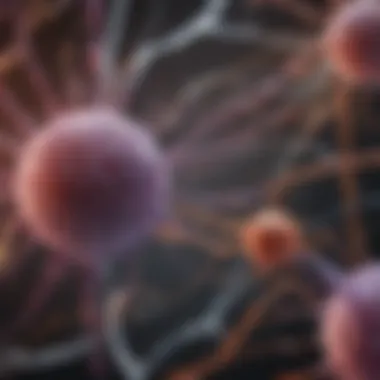Lif Cytokine: Mechanisms and Implications in Health


Intro
The exploration of cytokines has opened new doors to understanding complex biological processes involved in health and disease. Among these, leukemia inhibitory factor (Lif) has emerged as a significant player. This article aims to provide a comprehensive examination of Lif cytokine, discussing its multifaceted roles and implications across various systems in the body. Lif is not merely a signaling molecule; it has extensive interactions influencing immune responses, neurobiology, and cell differentiation.
Key Concepts
Definition of the Main Idea
Lif is a member of the interleukin-6 (IL-6) cytokine family, known for its ability to inhibit cell differentiation in certain contexts, which reveals its potential implications in various biological themes, such as inflammation and cancer progression. Understanding Lif involves deciphering its signaling mechanisms and functional outcomes in both physiological and pathological states.
Overview of Scientific Principles
Lif exerts its effects primarily through the Lif receptor (LIFR) and gp130 subunit, leading to activation of downstream signaling pathways. Notably, the JAK/STAT pathway is a cornerstone of Lif's mechanism of action. This pathway mediates a wide range of cellular functions, facilitating communication between cells and responding to external stimuli. The intricate interplay between Lif signaling and cellular responses underscores its relevance in health and disease contexts.
Current Research Trends
Recent Studies and Findings
Recent research surrounding Lif cytokine has steadily increased. Studies reveal its critical roles in immune response modulation, neurogenesis, and apoptosis. Researchers have also observed Lif's participation in conditions such as neurodegeneration and autoimmune diseases, indicating its potential as a therapeutic target.
Significant Breakthroughs in the Field
Breakthroughs in the understanding of Lif's roles have led to novel therapeutic interventions. For instance, manipulating Lif signaling pathways may offer new avenues for treating specific cancers and degenerative diseases. As our grasp of Lif's complexities expands, so too does its promise as a focal point for innovative medical research and applications.
Lif cytokine is not just a mediator of cellular responses; it represents a critical nexus linking various biological processes across different systems.
Lif cytokine is not just a mediator of cellular responses; it represents a critical nexus linking various biological processes across different systems.
Overall, the investigation into Lif is an evolving frontier that warrants attention from students, researchers, educators, and professionals alike. Its significance in health and disease can no longer be overlooked as science continues to unravel its mysteries.
Preface to Lif Cytokine
Lif cytokine holds a significant place in the study of immunology and cell biology. Understanding its role uncovers essential insights into various biological processes. Lif, or leukemia inhibitory factor, is not just a pivotal player in hematopoiesis but also influences neuronal development and immune responses. Recognizing these functions can lead to better therapeutic strategies in various disease contexts.
Definition and Discovery
Leukemia inhibitory factor was first identified in the context of leukemia, specifically its capacity to inhibit the proliferation of certain leukaemic cells. The initial discovery emphasized its significance in hematopoiesis, a process crucial to blood cell formation. Subsequent research demonstrated that Lif plays broader roles beyond the blood system. It is involved in embryonic development, neural growth, and even in modulating immune reactions. As a member of the interleukin-6 (IL-6) family of cytokines, Lif interacts with specific receptors on target cells, triggering complex signaling cascades that regulate critical biological events.
Classification of Cytokines
Cytokines can be classified based on their structure, function, and receptor type. Lif fits into the category of hematopoietic growth factors, specifically as a pleiotropic cytokine. Its classification extends across various families, including those influencing hematopoiesis, inflammation, and immunity. This classification is essential as it helps researchers pinpoint Lif’s functions in different biological contexts and how it can be targeted in therapeutic settings. Additionally, recognizing Lif's interactions with other cytokines can help elucidate its role in disease mechanisms, furthering our understanding of pathophysiology.
Understanding Lif and its categorization opens doors to vital explorations in medicine, psychiatry, and biotechnology. The implications of Lif's mechanisms can offer clarity in treating conditions ranging from cancer to neurodegenerative diseases by revealing how modulation of this cytokine could influence health outcomes.
Biological Functions of Lif


Understanding the biological functions of Lif (leukemia inhibitory factor) is essential to grasp its multifaceted role in various physiological and pathological processes. This section delineates the key functions of Lif in hematopoiesis, neuronal development, and immune responses, elucidating its significance in both health and disease contexts.
Role in Hematopoiesis
Lif plays a critical role in hematopoiesis, the process of blood cell formation. It influences the differentiation and proliferation of hematopoietic stem cells. Lif stimulates the formation of various blood cell types, including myeloid and lymphoid lineages. The signaling cascade initiated by Lif enhances the survival of these precursor cells, ensuring a robust supply of mature blood cells. This function is especially important during periods of stress, such as infection or injury, where the demand for new blood cells increases.
Additionally, Lif's interaction with its receptor promotes the expression of genes essential for cell survival and proliferation. Studies indicate that insufficient levels of Lif can lead to impaired hematopoiesis, contributing to conditions such as anemia or compromised immune function.
Impact on Neuronal Development
The impact of Lif on neuronal development is profound. Research shows that Lif is vital for the maintenance and differentiation of neurons. It supports the survival of neuronal precursor cells and aids in the formation of synapses, which are crucial for neuronal communication. Furthermore, Lif has been implicated in neurogenesis, the process wherein new neurons are generated from neural stem cells.
The neuroprotective effects of Lif extend to conditions like neurodegenerative diseases. Studies suggest that modulating Lif levels can have therapeutic effects in disorders such as Alzheimer's disease and Parkinson's disease. By enhancing neurogenesis and protecting existing neurons from apoptosis, Lif demonstrates its potential as a target for therapeutic interventions aimed at improving neuronal health and function.
Involvement in Immune Responses
Lif is also a key player in immune responses. It influences the activity of various immune cells, including T cells and monocytes. Lif's role in modulating cytokine production enhances the immune system's ability to respond to pathogens. It can assist in the transition of the immune response from an inflammatory stage to a resolution stage, which is critical for preventing chronic inflammation.
One interesting aspect of Lif's involvement in the immune system is its potential dual role in inflammation. While it contributes positively to the immune response, excessive Lif production may lead to pathological conditions. This is particularly relevant in autoimmune diseases where Lif's dysregulation can exacerbate the immune response against self-tissues.
Lif's involvement in immune responses illustrates its complexity; it can both support defenses against pathogens and contribute to tissue damage when disregulated.
Lif's involvement in immune responses illustrates its complexity; it can both support defenses against pathogens and contribute to tissue damage when disregulated.
In summary, the biological functions of Lif underscore its importance in multiple biological processes. Its role in hematopoiesis ensures the production of vital blood cells, while its impact on neuronal development supports the nervous system's health. Additionally, Lif's involvement in immune responses highlights its significance in maintaining a balanced immune system, with implications for various diseases. Understanding these functions informs ongoing research and therapeutic developments related to Lif.
Signaling Mechanisms of Lif
The signaling mechanisms of Lif (leukemia inhibitory factor) are crucial for understanding its diverse biological roles. These mechanisms dictate how Lif communicates with target cells, influencing various cellular responses. Through Lif receptors and downstream signaling pathways, cells are triggered to react in different ways depending on physiological or pathological contexts. A comprehensive grasp of these mechanisms is essential for recognizing how Lif can potentially be modulated for therapeutic purposes.
Lif Receptor Interaction
Lif signaling begins with its interaction with specific receptors. The main receptor for Lif is the Lif receptor (LIFR), which, upon binding with Lif, forms a complex with glycoprotein 130 (gp130). This interaction is a prerequisite for initiating downstream signaling cascades. The structure of the Lif-LIFR-gp130 complex reveals how Lif is able to activate signals that are vital for cell survival, growth and differentiation. It is this interaction that allows Lif to play its myriad roles in processes such as hematopoiesis and neurodevelopment.
Downstream Signaling Pathways
The activation of Lif receptors sparks several downstream signaling pathways, two of the most notable being the JAK/STAT pathway and the MAPK pathway. Each pathway has distinct functions and implications in cellular responses.
JAK/STAT Pathway
The JAK/STAT pathway is one of the critical signaling routes activated by Lif. It involves Janus kinases (JAKs), which phosphorylate and activate Signal Transducer and Activator of Transcription (STAT) proteins. Upon activation, these STAT proteins translocate into the nucleus to regulate gene expression. The significance of the JAK/STAT pathway lies in its widespread influence on various cellular mechanisms, ranging from differentiation to immune function. A key characteristic of this pathway is its rapid response time, allowing quick adjustments to cellular environments. This makes it a popular choice for discussions surrounding Lif, as its activation can lead to beneficial outcomes in immune responses. However, unregulated activation can also pave the way for disorders such as cancer due to excessive cellular proliferation.
MAPK Pathway
The MAPK pathway is another important signaling cascade triggered by Lif. Distinctly, this pathway is involved in the control of genetic expression, cellular proliferation, and survival. The MAPK pathway is characterized by its complex multi-tier signaling processes, which amplify the initial signal. The activation of this pathway by Lif is beneficial as it can enhance neuronal survival and contribute to tissue repair mechanisms. However, similar to the JAK/STAT pathway, excessive activation of the MAPK pathway may lead to aberrant cell growth, which is a concern in the context of cancer.


Regulatory Proteins and Feedback Mechanisms
The regulatory proteins that modulate Lif signaling mechanisms are vital in maintaining homeostasis. Feedback mechanisms ensure that the prolonged actions of Lif do not result in detrimental effects. Negative regulators like suppressors of cytokine signaling (SOCS) can inhibit the JAK/STAT pathway following its activation, preventing overactivation in immune responses. Such regulatory processes are essential in ensuring that Lif's contributions remain appropriately balanced, preventing unwanted pathological consequences in various biological contexts.
Lif Cytokine in Disease Contexts
The role of Lif cytokine in various disease contexts is essential to understanding its broader impact on human health. Lif is implicated in numerous pathological processes, including cancer progression and autoimmune diseases. Its ability to modulate immune responses and cell growth creates a complex interplay that researchers are eager to explore. Investigating Lif’s contributions can reveal potential therapeutic avenues and enhance our knowledge of disease mechanisms.
Role in Cancer Progression
Breast Cancer
Breast cancer remains one of the most prevalent cancers globally. Lif cytokine has been identified as a significant contributor in breast cancer progression. Its unique characteristic lies in its dual role as both a growth factor and a mediator of immune response. Lif can support tumor cell proliferation while also modulating the surrounding immune environment. This duality makes it a focal point for understanding tumor biology in breast cancer. In this context, studying Lif can provide insights into how tumors evade immune detection and grow more aggressively.
Key factors include its interaction with various signaling pathways that affect cell survival and migration. Understanding these mechanisms may lead to targeted therapies that disrupt these processes, showing promise in decreasing tumor aggressiveness.
Lung Cancer
Lung cancer presents another area where Lif’s involvement is critical. Lif cytokine appears to influence lung cancer development through pathways that affect tumor growth and metastasis. One key characteristic of lung cancer is its often late diagnosis and rapid progression. Lif's role as a growth factor in lung cancer cells can exacerbate this problem by promoting tumor expansion and spread.
Notably, the unique feature of Lif in lung cancer is its ability to interact with inflammatory processes in the lung microenvironment. This interaction might enrich tumor development and resilience, making it an important target for research. This makes Lif a beneficial subject to study, especially in understanding lung cancer's complexity and potential therapies.
Contributions to Autoimmune Diseases
Multiple Sclerosis
Multiple sclerosis (MS) is a chronic autoimmune disease characterized by inflammation and demyelination of the central nervous system. Lif cytokine has a notable contribution to the inflammatory processes seen in MS. Its regulation of immune cell behavior can affect the disease's progression, making it a focus for therapeutic exploration. One of the key characteristics of MS is the fluctuation in disease symptoms, often triggered by inflammatory responses, where Lif can play a pivotal role.
Lif’s capacity to support immune responses highlights both its potential and challenges in MS treatment. While it could theoretically modulate immune attacks on the nervous system, targeting Lif might also lead to unintended consequences in immune regulation. This duality creates a complex landscape for future research.
Rheumatoid Arthritis
In rheumatoid arthritis (RA), Lif cytokine's role is again pivotal. RA is marked by persistent inflammation in joints, leading to pain and disability. Lif contributes to the inflammatory milieu that governs RA severity. The key characteristic of RA lies in its chronic nature, where Lif can perpetuate inflammation and joint damage.
The unique feature of Lif in this context is its potential to influence synovial fibroblast activity, which can exacerbate joint inflammation. This understanding offers a basis for thinking about targeted treatments that could disrupt pathogenic mechanisms driven by Lif—an aspect that makes it a beneficial focus of study in this article.
Neurological Disorders and Lif Dysregulation
Alzheimer's Disease
Alzheimer's disease (AD) is a progressive neurodegenerative disorder. Lif’s involvement in AD highlights its role in neuronal survival and cognitive function. The key characteristic of AD is cognitive decline, markedly associated with neuroinflammation. Lif's dysregulation could contribute to pathological changes seen in AD, where it may fail to provide necessary support to neurons. This aspect is essential, as it underscores the need for further investigation into how Lif modulation could impact neuroprotective strategies.
The unique feature here is Lif's potential role in synaptic health. Dysregulation may impair synaptic transmission and contribute to cognitive deficits observed in patients. Understanding this could shape future interventions targeting Lif pathways to improve outcomes in AD.
Parkinson's Disease


Parkinson's disease (PD) is characterized by motor symptoms due to the loss of dopamine-producing neurons. Lif has implications in PD concerning neuroinflammation and neuronal survival. The key characteristic of PD is the gradual degeneration of motor control. Lif's role can influence the inflammatory processes that worsen neuronal loss. Research indicates that modulating Lif may offer a route to counteract these detrimental effects.
A unique feature in this situation is Lif's interactions with neuroprotective factors. Its dysregulation may accelerate neuronal death, highlighting its importance in maintaining neuronal health. This focus can help direct future research coursework aiming for effective therapeutic strategies.
Therapeutic Potential of Lif Modulation
Lif modulation holds significant promise in the realm of therapeutics. This cytokine, known for its complex roles in diverse biological processes, has emerged as a crucial target for intervention in a variety of diseases. Its therapeutic potential is rooted in its ability to influence cell differentiation, immune responses, and neuronal health. Furthermore, manipulating Lif levels can provide a strategic advantage in treating conditions characterized by dysregulation of these pathways.
As researchers continue to explore Lif's functions, new cytokine therapy approaches are being developed. These therapies aim to harness or inhibit the effects of Lif to improve patient outcomes. By targeting Lif, it is possible to alter the course of diseases where this cytokine plays a pivotal role. This section examines the various strategies being implemented in Lif modulation and their implications.
Cytokine Therapy Approaches
Cytokine therapy approaches targeting Lif range from direct administration to genetic modulation. Some key strategies include:
- Administration of Lif: Direct infusion of Lif has been explored for its potential to stimulate hematopoiesis and support neuronal survival. This approach seeks to enhance the natural functions of Lif in patients with deficiencies.
- Gene Therapy: Techniques that promote Lif gene expression can potentially correct deficiencies in patients suffering from related conditions. These methods offer a targeted strategy to increase endogenous Lif levels in the desired tissues.
- Combination Therapies: Combining Lif modulation with other therapies, like anti-inflammatory drugs, presents an opportunity to amplify treatment efficacy. For example, using Lif alongside immune-modulating agents may yield better outcomes in autoimmune diseases.
These cytokine therapy approaches illustrate the versatility of Lif as a therapeutic target, providing multiple avenues for intervention in disease contexts.
Lif Inhibitors and Their Mechanism of Action
Lif inhibitors represent a critical component in modulating the effects of this cytokine. By blocking Lif's action, these inhibitors can potentially mitigate its role in disease progression. The mechanisms through which Lif inhibitors operate include:
- Receptor Antagonism: Some inhibitors work by binding to Lif receptors, preventing Lif from exerting its effects. This blockade can reduce tumor growth rates in cancers influenced by Lif signaling.
- Downstream Signaling Disruption: By interfering with pathways such as JAK/STAT, Lif inhibitors can alter the signaling cascade initiated by Lif. This method can help in conditions where Lif promotes harmful cellular outcomes, such as chronic inflammation or excessive cell proliferation.
- Targeted Delivery Systems: New technologies are emerging to enhance the delivery of Lif inhibitors directly to affected tissues. This approach minimizes systemic side effects and maximizes efficacy, emphasizing precision medicine.
Overall, using Lif inhibitors paves the way for novel treatments in various disorders, particularly in oncology and chronic inflammatory conditions.
Clinical Trials and Future Perspectives
The current landscape of clinical trials exploring Lif modulation is dynamic and growing. Numerous studies focus on evaluating the safety and efficacy of Lif-targeting therapies:
- Ongoing Trials: Trials are assessing the impact of Lif inhibitors on diseases such as multiple sclerosis and specific cancer types. These studies are critical for understanding how Lif modulation can reshape treatment protocols.
- Emerging Technologies: Advances in biotechnology, such as CRISPR and viral vectors, are enhancing the ability to manipulate Lif levels with precision. As these technologies progress, they could revolutionize treatment strategies across a variety of conditions.
- Future Research Directions: Continued research into Lif's role in both health and disease will be essential. A deeper understanding of its mechanisms may unlock unforeseen therapeutic avenues, presenting potentially life-altering options for patients.
End
Understanding the role of Lif cytokine is crucial for advancing our knowledge in both health and disease contexts. The importance of this topic surfaces through various elements. Primarily, Lif plays a significant part in several biological processes such as hematopoiesis, neuronal development, and immune responses. Its multifaceted nature highlights why scrutinizing Lif's mechanisms is essential for grasping the underlying principles of cellular communication and regulation.
Summary of Findings
This article provides an in-depth exploration of Lif cytokine. It emphasizes its involvement in distinct biological functions, showing its regulatory capabilities in health and disease. Key findings include:
- Lif's critical role in supporting hematopoiesis, aiding both stem cell self-renewal and differentiation.
- Its significant impact on neuronal growth, which has implications for neurodegenerative diseases.
- The cytokine's engagement in immune responses, shedding light on how it modulates inflammation and potential autoimmunity.
Additionally, this piece discusses Lif's signaling mechanisms. The receptor interactions and downstream pathways like JAK/STAT and MAPK elucidate Lif's complex signaling landscape, emphasizing the need for targeted research and therapeutic considerations.
The Future of Lif Cytokine Research
The landscape of Lif cytokine research is evolving. Future investigations are likely to focus on its role in diseases, particularly cancer and autoimmune conditions. Unraveling Lif's involvement can lead to:
- Innovating therapeutic strategies that harness Lif modulation, promoting better clinical outcomes.
- Conducting clinical trials to assess the efficacy and safety of Lif-targeted therapies, fostering a new era in cytokine therapies.
- Understanding the interplay between Lif and other signaling molecules, paving the way for integradaed treatment approaches.
As research advances, we expect to uncover new roles and implications of Lif cytokine, potentially transforming how we approach various health issues.







